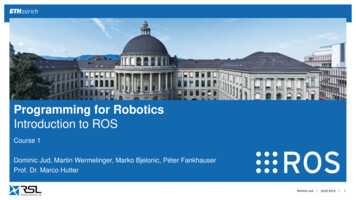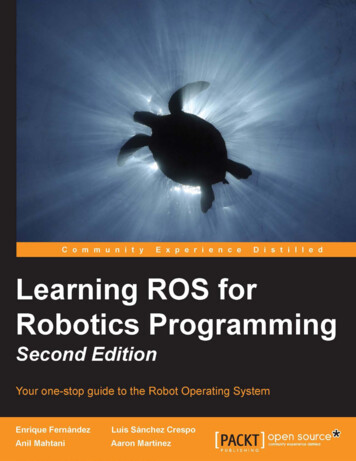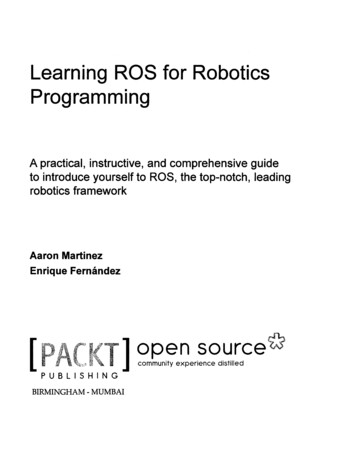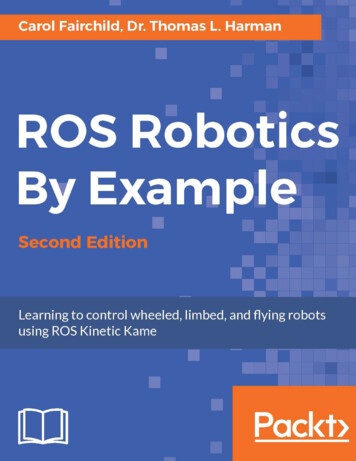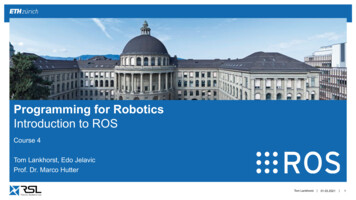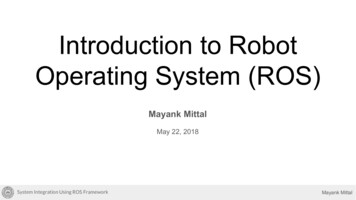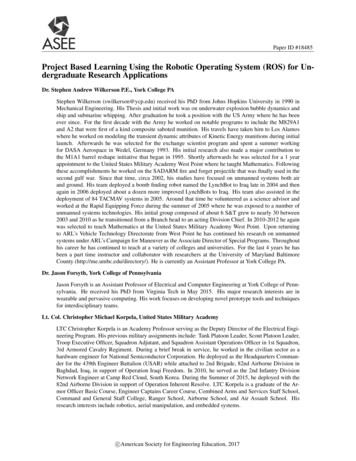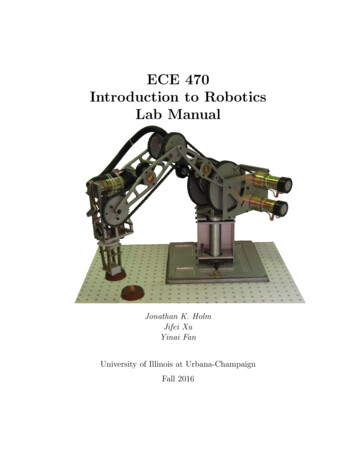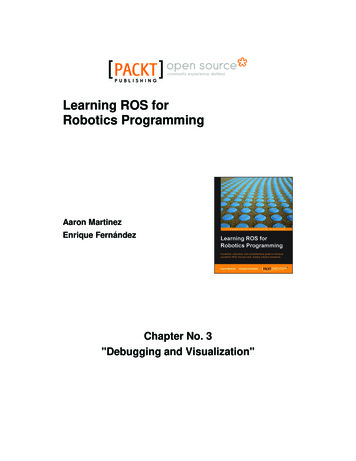
Transcription
Learning ROS forRobotics ProgrammingAaron MartinezEnrique FernándezChapter No. 3"Debugging and Visualization"
In this package, you will find:A Biography of the authors of the bookA preview chapter from the book, Chapter NO.3 "Debugging and Visualization"A synopsis of the book’s contentInformation on where to buy this bookAbout the AuthorsAaron Martinez is a computer engineer, entrepreneur, and expert in digital fabrication.He did his Master's thesis in 2010 at the IUCTC (Instituto Universitario de Ciencias yTecnologias Ciberneticas) in the University of Las Palmas de Gran Canaria. He preparedhis Master's thesis in the field of telepresence using immersive devices and roboticplatforms. After completing his academic career, he attended an internship program atThe Institute for Robotics in the Johannes Kepler University in Linz, Austria. During hisinternship program, he worked as part of a development team of a mobile platform usingROS and the navigation stack. After that, he was involved in some projects related torobotics, one of them is the AVORA project in the University of Las Palmas de GranCanaria. In this project, he worked on the creation of an AUV (Autonomous UnderwaterVehicle) to participate in the Student Autonomous Underwater Challenge-Europe(SAUC-E) in Italy. In 2012, he was responsible for manufacturing this project; in 2013,he helped to adapt the navigation stack and other algorithms from ROS to the roboticplatform.For More tics-programming/book
Recently, Aaron created his own company called Biomecan. This company works withprojects related to robotics, manufacturing of prototypes, and engineering tissue. Thecompany manufactures devices for other companies and research and developmentinstitutes. For the past two years, he has been working on engineering tissue projects,creating a new device to help researchers of cell culture.Aaron has experience in many fields such as programming, robotics, mechatronics, anddigital fabrication, many devices such as Arduino, BeagleBone, Servers, and LIDAR,servomotors, and robotic platforms such as Wifi bot, Nao Aldebaran, and Pioneer P3AT.I would like to thank my girlfriend who has supported me whilewriting this book and gave me motivation to continue growingprofessionally. I also want to thank Donato Monopoli, Head ofBiomedical Engineering Department at ITC (Canary-IslandsInstitute of Technology), and all the staff there.Thanks for teaching me all I know about digital fabrication,machinery, and engineering tissue. I spent the best years of my lifein your workshop. Thanks to my colleagues in the university,especially Alexis Quesada, who gave me the opportunity to createmy first robot in my Master's thesis. I have learned a lot aboutrobotics working with them.Finally, thanks to my family and friends for their help and support.Enrique Fernández is a computer engineer and roboticist. He did his Master's Thesis in2009 at the University Institute of Intelligent Systems and Computational Engineering inthe University of Las Palmas de Gran Canaria. There he has been working on his Ph.Dfor the last four years; he is expected to become a Doctor in Computer Science bySeptember 2013. His Ph.D addresses the problem of Path Planning for AutonomousUnderwater Gliders, but he has also worked on other robotic projects. He participated inthe Student Autonomous Underwater Challenge-Europe (SAUC-E) in 2012, andcollaborated for the 2013 edition. In 2012, he was awarded a prize for the developmentof an underwater pan-tilt vision system.Now, Enrique is working for Pal-Robotics as a SLAM engineer. He completed hisinternship in 2012 at the Center of Underwater Robotics Research in the University ofGirona, where he developed SLAM and INS modules for the Autonomous UnderwaterVehicles of the research group using ROS. He joined Pal-Robotics in June 2013, wherehe is working with REEM robots using the ROS software intensively and developing newnavigation algorithms for wheeled and biped humanoid robots, such as the REEM-H3and REEM-C.For More tics-programming/book
During his Ph.D, Enrique has published several conference papers and publications. Twoof these were sent to the International Conference of Robotics and Automation (ICRA) in2011. He is the co-author of some chapters of this book, and his Master's Thesis wasabout the FastSLAM algorithm for indoor robots using a SICK laser scanner and theodometry of a Pioneer differential platform. He also has experience with electronics andembedded systems, such as PC104 and Arduino. His background covers SLAM,Computer Vision, Path Planning, Optimization, and Robotics and Artificial Intelligencein general.I would like to thank my colleagues in the AVORA team, whichparticipated in the SAUC-E competition, for their strong collaborationand all the things we learned. I also want to thank the members of myresearch group at the University Institute of Intelligent Systems andComputational Engineering and the people of the Center of UnderwaterRobotics Research in Girona. During that time, I expended some of themost productive days of my life; I have learned a lot about robotics andhad the chance to learn player/stage/Gazebo and start with ROS. Also,thanks to my colleagues in Pal-Robotics, who have received me withopen arms, and have given me the opportunity to learn even more aboutROS and (humanoid) robots. Finally, thanks to my family and friendsfor their help and support.For More tics-programming/book
Learning ROS forRobotics ProgrammingLearning ROS for Robotics Programming gives you a comprehensive review of ROStools. ROS is the Robot Operating System framework, which is used nowadays byhundreds of research groups and companies in the robotics industry. But it is also thepainless entry point to robotics for nonprofessional people. You will see how to installROS, start playing with its basic tools, and you will end up working with state-of-the-artcomputer vision and navigation tools.The content of the book can be followed without any special devices, and each chaptercomes with a series of source code examples and tutorials that you can run on your owncomputer. This is the only thing you need to follow in the book.However, we also show you how to work with hardware, so that you can connect youralgorithms with the real world. Special care has been taken in choosing devices which areaffordable for amateur users, but at the same time the most typical sensors or actuators inrobotics research are covered.Finally, the potential of ROS is illustrated with the ability to work with whole robotsin a simulated environment. You will learn how to create your own robot and integrateit with the powerful navigation stack. Moreover, you will be able to run everything insimulation, using the Gazebo simulator. We will end the book by providing a list of realrobots available for simulation in ROS. At the end of the book, you will see that you canwork directly with them and understand what is going on under the hood.What This Book CoversChapter 1, Getting Started with ROS, shows the easiest way you must follow in order tohave a working installation of ROS. You will see how to install different distributions ofROS, and you will use ROS Fuerte in the rest of the book. How to make an installationfrom Debian packages or compiling the sources, as well as making installations in virtualmachines, have been described in this chapter.Chapter 2, The ROS Architecture with Examples, is concerned with the concepts andtools provided by the ROS framework. We will introduce you to nodes, topics, andservices, and you will also learn how to use them. Through a series of examples, we willillustrate how to debug a node or visualize the messages published through a topic.For More tics-programming/book
Chapter 3, Debugging and Visualization, goes a step further in order to show youpowerful tools for debugging your nodes and visualize the information that goes throughthe node's graph along with the topics. ROS provides a logging API which allows you todiagnose node problems easily. In fact, we will see some powerful graphical tools such asrxconsole and rxgraph, as well as visualization interfaces such as rxplot and rviz. Finally,this chapter explains how to record and playback messages using rosbag and rxbag.Chapter 4, Using Sensors and Actuators with ROS, literally connects ROS with the realworld. This chapter goes through a number of common sensors and actuators that aresupported in ROS, such as range lasers, servo motors, cameras, RGB-D sensors, andmuch more. Moreover, we explain how to use embedded systems with microcontrollers,similar to the widely known Arduino boards.Chapter 5, 3D Modeling and Simulation, constitutes one of the first steps in order toimplement our own robot in ROS. It shows you how to model a robot from scratch andrun it in simulation using the Gazebo simulator. This will later allow you to use the wholenavigation stack provided by ROS and other tools.Chapter 6, Computer Vision, shows the support for cameras and computer vision tasks inROS. This chapter starts with drivers available for FireWire and USB cameras, so thatyou can connect them to your computer and capture images. You will then be able tocalibrate your camera using ROS calibration tools. Later, you will be able to use theimage pipeline, which is explained in detail. Then, you will see how to use several APIsfor vision and integrate OpenCV. Finally, the installation and usage of a visual odometrysoftware is described.Chapter 7, Navigation Stack – Robot Setups, is the first of two chapters concerned withthe ROS navigation stack. This chapter describes how to configure your robot so that itcan be used with the navigation stack. In the same way, the stack is explained, along withseveral examples.Chapter 8, Navigation Stack – Beyond Setups, continues the discussion of the previouschapter by showing how we can effectively make our robot navigate autonomously. Itwill use the navigation stack intensively for that. This chapter shows the great potential ofROS using the Gazebo simulator and rviz to create a virtual environment in which we canbuild a map, localize our robot, and do path planning with obstacle avoidance.Chapter 9, Combining Everything – Learn by Doing, builds from the previous chaptersand shows a number of robots which are supported in ROS using the Gazebo simulator.In this chapter you will see how to run these robots in simulation and perform several ofthe tasks learned in the rest of the book, especially those related to the navigation stack.For More tics-programming/book
Debugging and VisualizationThe ROS framework comes with a great number of powerful tools to help the userand developer in the process of debugging the code, and detecting problems withboth the hardware and software. This comprises debugging facilities such as logmessages as well as visualization and inspection capabilities, which allows the userto see what is going on in the system easily.Here, we also cover the workflow to debug ROS nodes using GDB debugger as anexample. Although this is almost the same as debugging a regular C/C program,there are a few aspects that must be taken into account. We will only focus on theseparticular aspects, since explaining the way to use the debugger is far from the scope ofthis chapter. You are encouraged to read the GDB reference and user manual for this.ROS provides an API for logging, which allows setting different logging levels,depending on the semantics of the message to output or print. This is not onlywith the aim of helping debugging but also to have more informative and robustprograms in case of failure. As we will see later, we can inform the user about thestages in the process of an algorithm with high-level informative messages, whilealso warning the user about missed values or parameters as well as regular or fatalerrors, which are unrecoverable.For More tics-programming/book
Debugging and VisualizationHowever, once our program compiles and runs, it might still fail. At this point,two major things could be happening; first, a problem related to the nodes, topics,services, or any other ROS element, or second, an issue caused by our algorithmitself. ROS provides a set of powerful tools to inspect the state of the system, whichinclude the node's graph, with all the connections (publishers and subscribers)among topics as shown in the following screenshot. Both local and remote nodesare seamlessly addressed, so the user can easily and rapidly detect a problem ina node that is not running or a missed topic connection.Up to some extent, a bunch of generic plotting tools are provided to analyze theoutput or results of our own algorithms so that it becomes easier to detect bugs.First of all, we have time series plots for scalar values, which might be fields of themessages transferred between nodes. Then, there are tools to show images, evenwith support for stereo pairs. Last but not least, we have 3D visualization toolssuch as rviz, as shown in the following screenshot, for the PR2 robot. They allowrendering point clouds, laser scans, and so on. As an important characteristic, alldata belongs to a topic that is placed on a frame so that the data is rendered in thatframe. A robot is generally a compound of many frames with transform framesamong them. To help the user to see the relationships among them, we also havetools to watch the frame hierarchy at a glance.[ 64 ]For More tics-programming/book
Chapter 3In the upcoming sections, we will cover the following aspects: Debugging and good practices for developing code when creating ROS nodes. Adding logging messages to our code and setting different levels, from debugmessages to errors, or even fatal ones. Giving names, applying conditions, and throttling the logging messages,which becomes very useful in large projects. Presenting a graphical tool to manage all the messages. Inspecting the state of the ROS system by listing the nodes running andthe topics and services available. Visualizing the node's graph representation, which are connected bypublishing and subscribing to topics. Plotting scalar data of certain messages. Visualizing scalar data for complex types. In particular, we will cover imagesand the case of FireWire cameras, which are seamlessly supported in ROS,as well as the 3D visualization of many topic types. Explaining what frames are and their close relationship with the messagespublished by the topics. Similarly, we will see what a frame transformationin the TF tree is. Saving the messages sent by topics and how to replay them for simulationor evaluation purposes.[ 65 ]For More tics-programming/book
Debugging and VisualizationDebugging ROS nodesIn order to detect problems in the algorithms implemented inside ROS nodes,we can face the problem at different levels to make the debugging of the softwareeasier. First, we must provide some readable information about the progress of thealgorithm, driver, or another piece of software. In ROS, we have a set of loggingmacros for this particular purpose, which are completely integrated with the wholesystem. Second, we need tools to determine which verbosity level is desired for agiven node; this is related to the ability to configure different logging levels. In thecase of ROS, we will see how it is possible to set debugging/logging levels even onthe fly as well as conditions and names for particular messages. Third, we must beable to use a debugger to step over the source code. We will see that the widely knownGDB debugger integrates seamlessly with ROS nodes. Finally, at the abstraction (orsemantic) level of ROS nodes and topics, it is useful to inspect the current state of thewhole system. Such introspection capabilities in ROS are supported by means of toolsthat draw the nodes graph with connections among topics. The user or developer caneasily detect a broken connection at a glance, as we will explain later in another section.Using the GDB debugger with ROS nodesWe will start with the standard way of debugging C/C executables of any kind.The flexibility of ROS allows using the well-known GDB debugger with a regularC/C program. All we have to know is the location of our executable, which in thecase of ROS would be a node implemented in C . Therefore, we only have to moveto the path that contains the node binary and run it within GDB. Indeed, we couldalso run our node directly without the typical rosrun package node syntax.To make it simple, we will show you how to run a node in GDB for the example1node in the chapter3 tutorials package. First, move to the package with roscdas follows:roscd chapter3 tutorialsThen, we only have to recall that C binaries are created inside the bin folderof the package folder's structure. Hence, we simply run it inside GDB using thefollowing command:gdb bin/example1Remember that you must have a roscore commandrunning before you start your node because it will needthe master/server running.[ 66 ]For More tics-programming/book
Chapter 3Once roscore is running, you can start your node in GDB by pressing the R keyand Enter. You can also list the associated source code with the L key as well as setbreakpoints or any of the functionalities that GDB comes with. If everything workscorrectly, you should see the following output in the GDB terminal after you haverun the node inside the debugger:(gdb) rStarting program: /home/enrique/dev/rosbook/chapter3 tutorials/bin/example1[Thread debugging using libthread db enabled]Using host libthread db library "/lib/x86 64-linux-gnu/libthreaddb.so.1".[New Thread 0x7ffff2664700 (LWP 3204)].[Thread 0x7ffff1e63700 (LWP 3205) exited][Inferior 1 (process 3200) exited normally]Attaching a node to GDB while launching ROSIf we have a launch file to start our node, we have some attribute in the XML syntaxthat allows us to attach the node to a GDB session. For the previous node, example1,in the package chapter3 tutorials, we will add the following node element to thelaunch file: launch node pkg "chapter3 tutorials" type "example1"name "example1"/ /launch Note that the package is passed to the pkg attribute and the node to the typeattribute. We also have to give this instance of the node a name since we can runmore than one instance of the same node. In this case, we gave the same name as thenode type, that is, the name attribute, which has the value example1. It is also a goodpractice to set the attribute output to screen, so the debugging messages, whichwe will see in the following code snippet, appear on the same terminal where welaunched the node: node pkg "chapter3 tutorials" type "example1"name "example1" output "screen"/ [ 67 ]For More tics-programming/book
Debugging and VisualizationTo attach it to GDB, we must add launch-prefix "xterm -e gdb --args": launch node pkg "chapter3 tutorials" type "example1"name "example1" output "screen"launch-prefix "xterm -e gdb --args"/ /launch What this prefix does is very simple. It starts GDB, loads our node, and waits untilthe user presses the C or R key; that is, the node is loaded but waiting to run. Thisway the user can set breakpoints before the node runs and interact as a regular GDBsession. Also, note that a new window opens up. This is because we create the GDBsession in xterm, so we have a debugging window separated from the programoutput window.Additionally, we can use the same attribute to attach the node to other diagnostictools; for example, we can run valgrind on our program to detect memory leaksand perform some profiling analysis. For further information on valgrind, you cancheck out http://valgrind.org. To attach our node to it, we proceed in a similarway as we did with GDB. In this case, we do not need an additional window, sothat we do not start xterm, and simply set valgrind as the launch prefix: launch node pkg "chapter3 tutorials" type "example1"name "example1" output "screen"launch-prefix "valgrind"/ /launch Enabling core dumps for ROS nodesAlthough ROS nodes are actually regular executables, there are some tricky pointsto note to enable core dumps that can be used later in a GDB session. First of all,we have to set an unlimited core size. Note that this is required for any executable,not just ROS nodes:ulimit -c unlimitedThen, to allow core dumps to be created, we must set the core filename to use theprocess pid by default; otherwise, they will not be created because at ROS HOME,there is already a core directory to prevent core dumps. Therefore, in order tocreate core dumps with the name and path ROS HOME/core.PID, we must dothe following:echo 1 /proc/sys/kernel/core uses pid[ 68 ]For More tics-programming/book
Chapter 3Debugging messagesIt is good practice to include messages that indicate what the program is doing.However, we must do it without compromising the efficiency of our software andthe clearance of its output. In ROS, we have an API that covers both features and isbuilt on top of log4cxx (a port of the well-known log4j logger library). In brief, wehave several levels of messages, which might have a name depending on a conditionor even throttle, with a null footprint on the performance and full integration withother tools in the ROS framework. Also, they are integrated seamlessly with theconcurrent execution of nodes, that is, the messages do not get split, but they canbe interleaved according to their timestamps. In the following sections, we willexplain the details and how to use them adequately.Outputting a debug messageROS comes with a great number of functions or macros that allow us to output adebugging message as well as errors, warnings, or simply informative messages.It offers a great functionality by means of message (or logging) levels, conditionalmessages, interfaces for STL streams, and much more. To put things in a simple andstraightforward fashion, in order to print an informative message (or information),we can do the following at any point in the code:ROS INFO( "My INFO message." );Note that we do not have to include any particular library in our source code aslong as the main ROS header is included. However, we can add the ros/console.hheader as shown in the following code snippet:#include ros/ros.h #include ros/console.h As a result of running a program with the preceding message, we will have thefollowing output:[ INFO] [1356440230.837067170]: My INFO message.All messages are printed with its level and the current timestamp (your outputmight differ for this reason) before the actual message and both these values arebetween square brackets. The timestamp is the epoch time, that is, the secondsand nanoseconds since 1970 followed by our message.[ 69 ]For More tics-programming/book
Debugging and VisualizationThis function allows parameters in the same way as the printf function in C.This means that we can pass values using all special characters that we can usewith printf; for example, we can print the value of a floating point number inthe variable val with this code:const double val 3.14;ROS INFO( "My INFO message with argument: %f", val );Also, C STL streams are supported with * STREAM functions. Therefore, theprevious instruction is equivalent to the following using streams:ROS INFO STREAM("My INFO stream message with argument: " val);Please note that we did not specify any stream because it is implicit that we refer tocout or cerr, depending on the message level, as we will see in the next section.Setting the debug message levelROS comes with five classic logging levels, which are in the order of relevance.They are DEBUG, INFO, WARN, ERROR, and FATAL.These names are part of the function or macro used to output messages that followsthis syntax:ROS LEVEL [ OTHER ]Both DEBUG and INFO messages go to cout (or stdout). Meanwhile, WARN, ERROR,and FATAL go to cerr (or stderr). Also, each message is printed with a particularcolor as long as the terminal has this capability. The colors are DEBUG in green,INFO in white, WARN in yellow, ERROR in red, and FATAL in purple.The names of these messages clearly say the typology of the message given.The user must use them accordingly. As we will see in the following sections,this allows us to output only messages starting at a user-defined minimum levelso that debugging messages can be omitted when our code is stable. Additionally,we have OTHER variants that are explained in the sequel.Downloading the example codeYou can download the example code files for all Packt books you havepurchased from your account at http://www.packtpub.com. If youpurchased this book elsewhere, you can visit http://www.packtpub.com/support and register to have the files e-mailed directly to you.You can also download these code files from https://github.com/AaronMR/Learning ROS for Robotics Programming.[ 70 ]For More tics-programming/book
Chapter 3Configuring the debugging level of aparticular nodeBy default, only messages of INFO or a higher level are shown. ROS uses the levels tofilter the messages printed by a particular node. There are many ways to do so. Someof them are set at the compile time, while others can be changed before executionusing a configuration file. It is also possible to change this level dynamically, as wewill see later in the following sections, using rosconsole and rxconsole.First, we will see how to set the debugging level at compile time in our source code.Just go to the main function, and after the ros::init call, insert the following code:// Set the logging level manually to DEBUGROSCONSOLE AUTOINIT;log4cxx::LoggerPtr my logger log4cxx::Logger::getLogger( ROSCONSOLE DEFAULT NAME );my logger- setLevel(ros::console::g level lookup[ros::console::levels::Debug]);You do not need to include any particular header, but in the CMakeLists.txt file,we must link the header to the log4cxx library. To do so, we must put:find library(LOG4CXX LIBRARY log4cxx)And our node must link to it:rosbuild add executable(example1 src/example1.cpp)target link libraries(example1 {LOG4CXX LIBRARY})Now, DEBUG (and higher) messages are shown when our node runs since weset ros::console::levels::Debug in the preceding example. You can run theexample1 node to check it and even change the level.An alternative to the preceding method consists of using the compile-time-loggerremoval macros. Note that this will remove all the messages below a given levelat compilation time, so later we will not have them; this is typically useful for therelease build of our programs. To do so, we must set ROSCONSOLE MIN SEVERITYto the minimum severity level or even none, in order to avoid any message (evenFATAL); this macro can be set in the source code or even in the CMakeLists.txtfile. The macros are ROSCONSOLE SEVERITY DEBUG, ROSCONSOLE SEVERITY INFO,ROSCONSOLE SEVERITY WARN, ROSCONSOLE SEVERITY ERROR, ROSCONSOLESEVERITY FATAL, and ROSCONSOLE SEVERITY NONE.[ 71 ]For More tics-programming/book
Debugging and VisualizationThe ROSCONSOLE MIN SEVERITY macro is defined in ros/console.h as DEBUG if notgiven. Therefore, we can pass it as a built argument (with -D) or put it before all theheaders; for example, to show only ERROR (or higher) messages we will execute thefollowing code as we did in the example2 node:#define ROSCONSOLE MIN SEVERITY ROSCONSOLE SEVERITY DEBUGOn the other hand, we have a more flexible solution of setting the minimumdebugging level in a configuration file. We will create a folder, just for convenience,named config with the file chapter3 tutorials.config and this content:log4j.logger.ros.chapter3 tutorials DEBUGWe can put any of the levels supported in ROS. Then, we must set the ROSCONSOLECONFIG FILE environment variable to point our file. However, there is a betteroption. It consists of using a launch file that does this and also runs our nodedirectly. Therefore, we can extend the launch files shown before to do so withan env element as shown in the following code snippet: launch !-- Logger config -- env name "ROSCONSOLE CONFIG FILE"value " (find chapter3 tutorials)/config/chapter3 tutorials.config"/ !-- Example 1 -- node pkg "chapter3 tutorials" type "example1" name "example1"output "screen"/ /launch The environment variable takes the config file, described previously, that containsthe logging level specification for each named logger. Then, in the launch file, ournode is simply run.Giving names to messagesSince we can put messages in many places inside the same node, ROS allows usto give a name to each node in our program. This way, later on, it will be easier todetect from which part of the code is such a message coming. To do so, we use theROS LEVEL [ STREAM] NAMED function as shown in the following code snippet(taken from the example2 node):ROS INFO STREAM NAMED("named msg","My named INFO stream message; val " val);[ 72 ]For More tics-programming/book
Chapter 3With named messages, we can go back to the config file and set different debugginglevels for each named message. This allows for fine tuning using the name of themessages as the children of the node in the specification; for example, we can set thenamed msg messages that are shown only for the ERROR (or higher) level with (notethat alt
Learning ROS for Robotics Programming . Learning ROS for Robotics Programming gives you a comprehensive review of ROS tools. ROS is the Robot Operating System framework, which is used nowadays by hundreds of research groups and companies in the robotics industry. But it is also the painless entry point to robotics for nonprofessional people.
